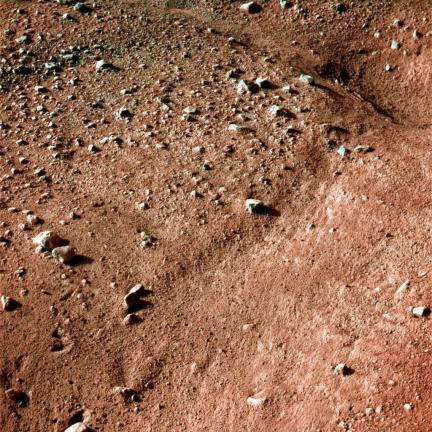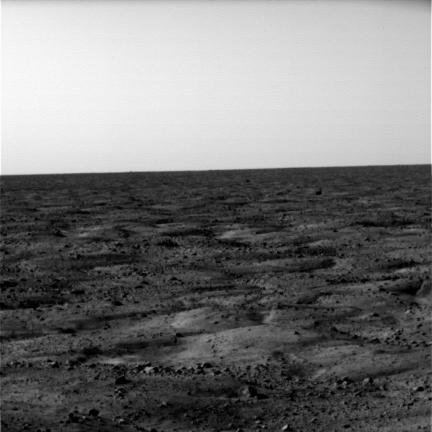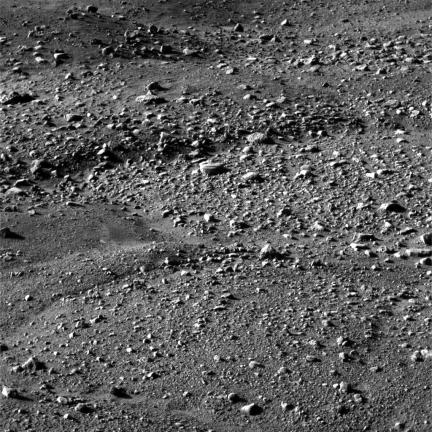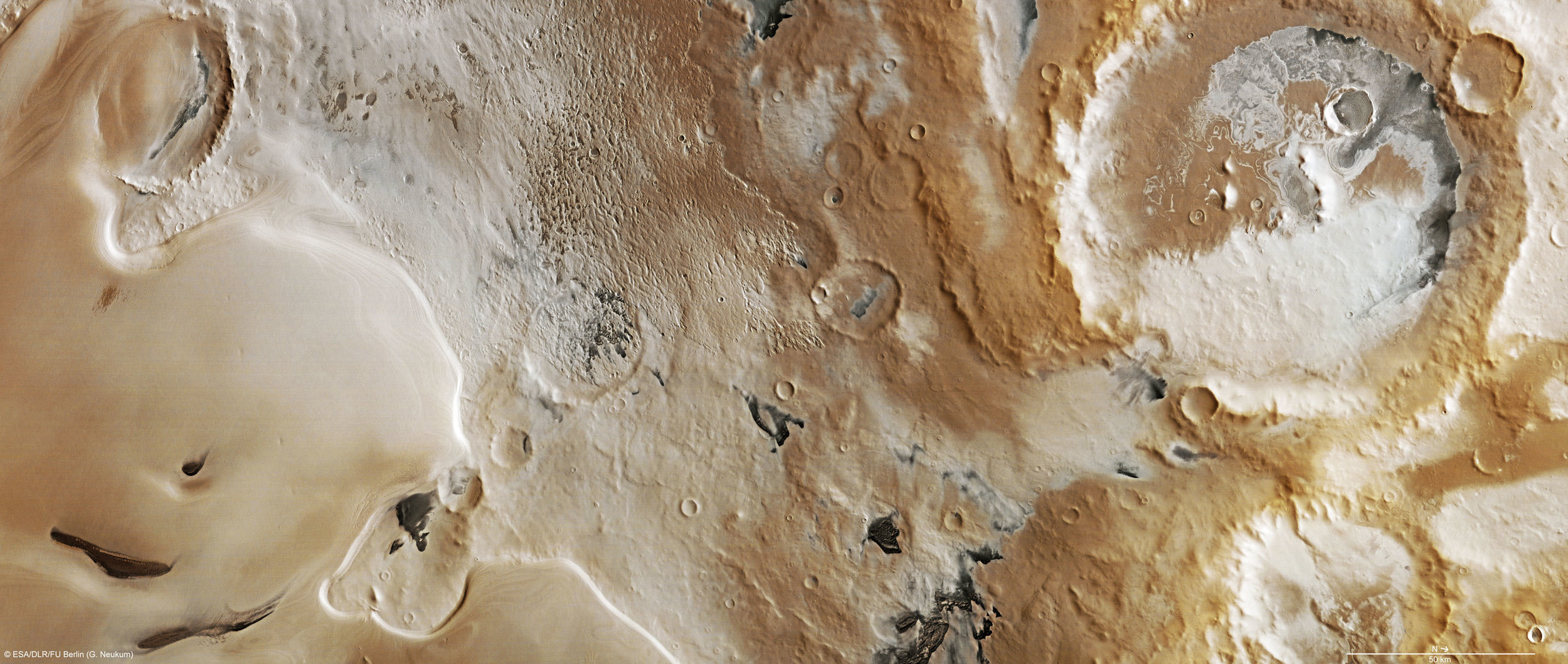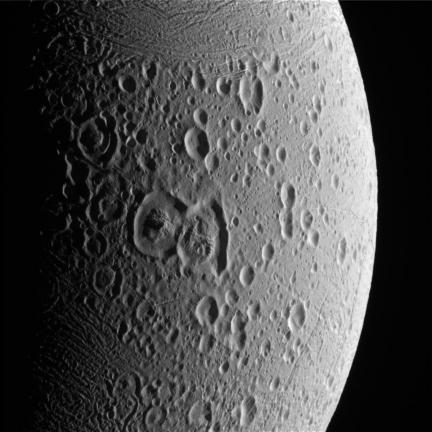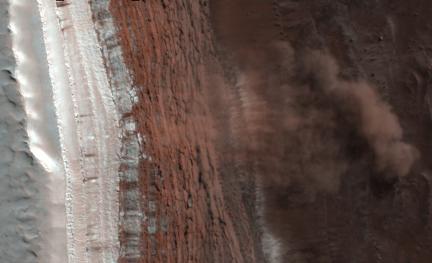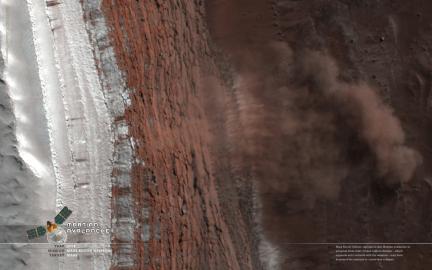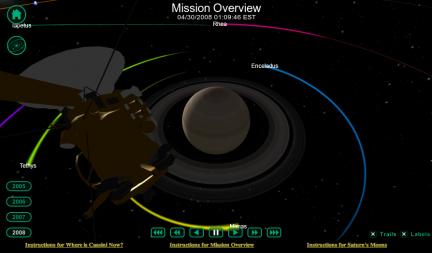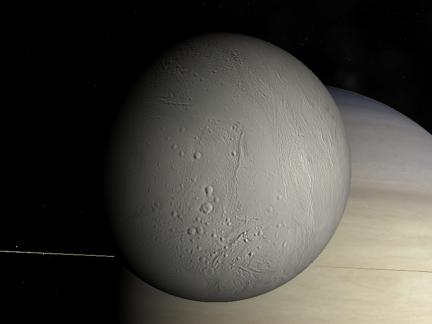First Images From Phoenix
This mission is not likely to be very exciting in the imaging. So far most of what has been returned looks more like the more ordinary images returned by the Mars Rovers. The real excitement of this mission is drilling for the water ice. The first images are look a whole lot like an old moon mission from the early sixties:
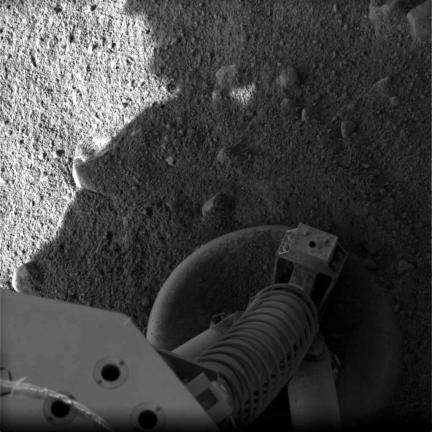
The horizon from Phoenix. You can now see the features that made up the cantaloupe-like texture of the images of this region from orbit.
Phoenix is on Martian Ground
Area Where Phoenix is Expected to Land
 See also.
See also.
Phoenix Lands in 3 Days
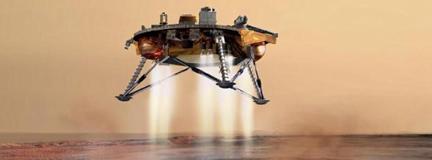 Official website is here and the official blog.
Official website is here and the official blog.
Oh My… What Did Earth Do Now?
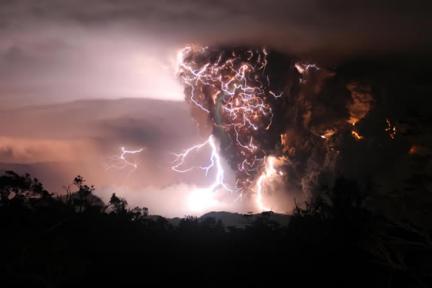 I don’t usually post terrestrial images of Earth… but this forces an exception.
I don’t usually post terrestrial images of Earth… but this forces an exception.
Mars Phoenix: May 25th Landing Site
 Getting ready for the next Martian visitor!
Getting ready for the next Martian visitor!
This image is taken within the region that Mars Phoenix is expected to land on May 25th, one month from today. The whitish areas criss-crossing the landscape here is the seasonal carbon dioxide frost that covers the Martian poles during the winter. Phoenix will represent the first ever landing in a Martian polar region and is expected to yield considerably different results than we have seen from any of the previous landers or rovers.
Phobos as Seen by MRO
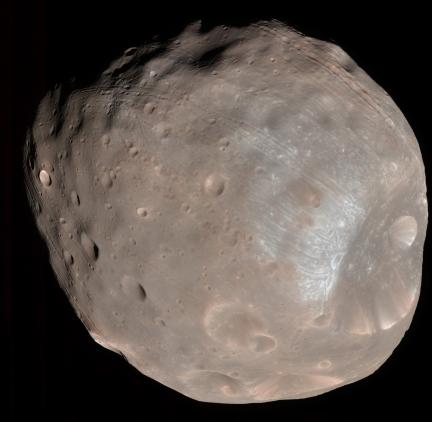 This is a semi-false color image as explained on NASA’s site, “The High Resolution Imaging Science Experiment (HiRISE) camera on NASA's Mars Reconnaissance Orbiter took this image of the larger of Mars' two moons, Phobos… on March 23, 2008. Taken from a distance of about 6,800 kilometers (about 4,200 miles). It is presented in color by combining data from the camera's blue-green, red, and near-infrared channels”.
This is a semi-false color image as explained on NASA’s site, “The High Resolution Imaging Science Experiment (HiRISE) camera on NASA's Mars Reconnaissance Orbiter took this image of the larger of Mars' two moons, Phobos… on March 23, 2008. Taken from a distance of about 6,800 kilometers (about 4,200 miles). It is presented in color by combining data from the camera's blue-green, red, and near-infrared channels”.
So there is some exaggeration of color here by including the infrared. I am guessing that is what is making the contrast between the reddish hues and those whitish marking at the edge of Stickney Crater. Click to see the hi-res… this may be the sharpest most detailed of Phobos I have seen yet.
Mars: Promethei Planum
Plume Diving: The Departure
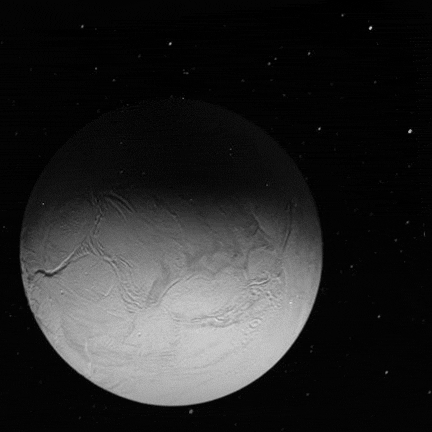 Cassini moves away from it’s risky encounter at Enceladus… This came out so cool that it looks fake.
Cassini moves away from it’s risky encounter at Enceladus… This came out so cool that it looks fake.
IMAGE NOTE: 3 frames of this 13 frame animation were “faked” in that adjacent frames were used to fill in gaps. The size and position of Enceladus was simply adjusted on these frames to create a smoother transition where needed. Additionally, the last 3 frames had stars added to the background for consistency.
Enceladus Unlit by the Sun
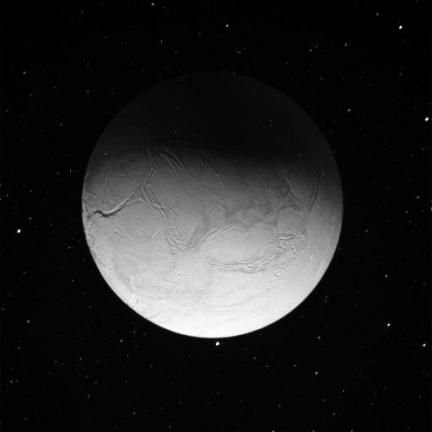 The almost surreal nature of this image is due to this: Nothing in this image is sunlit. According to Emily Lackdawalla’s Planetary Society blog, the lower brightest area is lit by the rings of Saturn, by way of reflection off of Saturn’s disc. The right hand side is comparatively low-lit by the moons Tethys and Dione and the left side is also low-lit by the moon Rhea. To the human eye, this scene would appear far darker than seen here and is a testament to the sensitivity of Cassini’s cameras in low-lit situations. If the sun-lit side of Enceladus presented itself here, it would be a complete white out devoid of any details.
The almost surreal nature of this image is due to this: Nothing in this image is sunlit. According to Emily Lackdawalla’s Planetary Society blog, the lower brightest area is lit by the rings of Saturn, by way of reflection off of Saturn’s disc. The right hand side is comparatively low-lit by the moons Tethys and Dione and the left side is also low-lit by the moon Rhea. To the human eye, this scene would appear far darker than seen here and is a testament to the sensitivity of Cassini’s cameras in low-lit situations. If the sun-lit side of Enceladus presented itself here, it would be a complete white out devoid of any details.
My best guess for all the dots is that some are actually star light, while others are anomalies in the imaging process… for instance, the specks in the image that appear over the disc itself are surely noise.
Enceladus Flyby: A Quick Mosaic
Made partly from the image from the previous post. Click to see it high resolution.

There is word also that some of the instruments failed to relay data. This would be disappointing to say the least. Considering the risk taken to get this close to the plumes… it would be sad to not have the data they were looking for.
An Early Look
It’s Go Time Cassini!
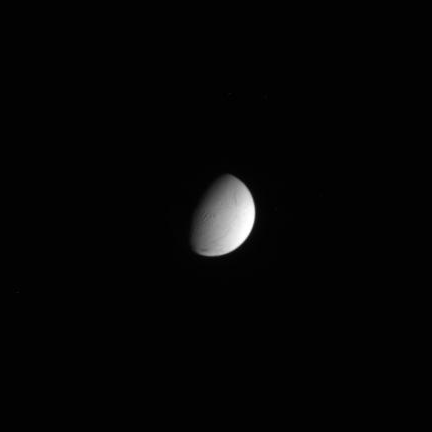 Tonight is the night! Image was taken 2 days before Cassini’s dive through the fountains of Enceladus.
Tonight is the night! Image was taken 2 days before Cassini’s dive through the fountains of Enceladus.
Cassini Goes Plume Diving in 2 Days
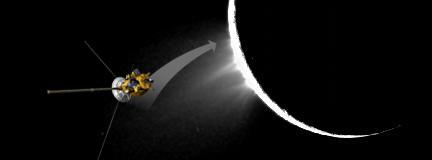 The flyby of Enceladus that will take Cassini directly through the plumes is only 2 days off. Could be one of the best events of the year.
The flyby of Enceladus that will take Cassini directly through the plumes is only 2 days off. Could be one of the best events of the year.
Rings at Rhea?
Some scientists believe that they have stumbled upon the first ever detected rings around a moon. As if that were not interesting enough — these theoretical rings would also be the only rings ever found around a body that is not a gas giant such as Saturn, Jupiter, Uranus or Neptune. As a matter of fact, Rhea isn’t even one of the larger moons of the Solar System. If these rings exist they are sparse and made of small particles, so Cassini is unlikely to ever detect these particles with the cameras its is equipped with. Therefore, there are no actual images to support this theory… but it is interesting enough that I feel compelled to at least point interested space fans to a great article explaining the theory on the Planetary Society’s blog.
Martian Avalanche!
 In the referential image above, two avalanches were captured in action by the Mars Reconnaissance Orbiter. The larger of these two (B) is around 180 meters wide, extends about 190 meters and the cliff heights are around 700 meters tall. The White material on the top that appears as snow is actually carbon dioxide frost which is currently receding as the Martian Spring moves closer. It is this very process which may be the cause of such falls as the carbon dioxide frost expands and contracts with the changing seasonal temperatures. Despite these seasonal changes, most areas of the Martian surface have likely been unchanged for millions of years, so it is quite rare to capture such cataclysmic activities in a single image from orbit.
In the referential image above, two avalanches were captured in action by the Mars Reconnaissance Orbiter. The larger of these two (B) is around 180 meters wide, extends about 190 meters and the cliff heights are around 700 meters tall. The White material on the top that appears as snow is actually carbon dioxide frost which is currently receding as the Martian Spring moves closer. It is this very process which may be the cause of such falls as the carbon dioxide frost expands and contracts with the changing seasonal temperatures. Despite these seasonal changes, most areas of the Martian surface have likely been unchanged for millions of years, so it is quite rare to capture such cataclysmic activities in a single image from orbit.
IMAGE NOTE: The images above are listed as RGB, but the accompanying text describes all the images as “false color”. Guess – maybe it means the colors are natural but exaggerated? See below for 1440x900 landscape wallpaper.
A Triple!
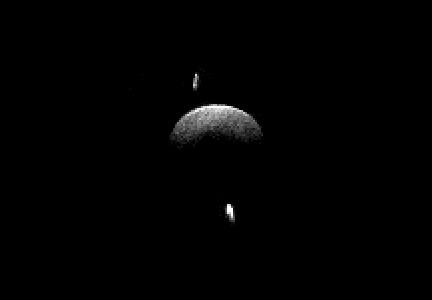 Just in time for Valentine’s Day… a ménage à tous! Aricebo captured this radar image of asteroid 2001SN263 which turned out to be a triple asteroid. This is the first near-Earth object found to have more than one moonlet. Is it just me or does that main asteroid seem orb-like?
Just in time for Valentine’s Day… a ménage à tous! Aricebo captured this radar image of asteroid 2001SN263 which turned out to be a triple asteroid. This is the first near-Earth object found to have more than one moonlet. Is it just me or does that main asteroid seem orb-like?
Carnival of Space #39
CASSIE the Online Cassini Simulator
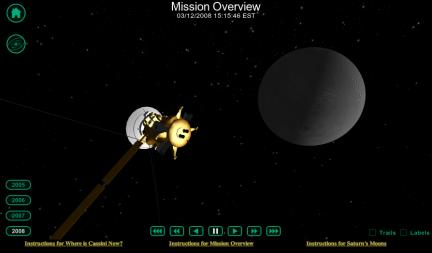 Go over and check out the interactive Cassini simulator at saturn.jpl.nasa.gov. Shown above is the simulator’s view of Cassini’s upcoming Enceladus flyby. Scale at this view is not terribly accurate as when you spin the view around — it will seem as if the spacecraft is the same size as the moon. However, it is pretty cool watching the mission in high speed with the labels and orbit trails turned on as seen below.
Go over and check out the interactive Cassini simulator at saturn.jpl.nasa.gov. Shown above is the simulator’s view of Cassini’s upcoming Enceladus flyby. Scale at this view is not terribly accurate as when you spin the view around — it will seem as if the spacecraft is the same size as the moon. However, it is pretty cool watching the mission in high speed with the labels and orbit trails turned on as seen below.
You will probably have to install a plug-in to use this, but it is quite simple. It should take care of itself for PC users, for MAC users you only need to download the installer and execute the installation from wherever your downloaded files reside. Some platforms may require restarting the browser should the plug-in appear to not be working after installation.
If this isn’t impressive enough for you and you want to go hard-core, try downloading CELESTIA. This is an application based simulator of our galaxy that is supported by a community of users which expand the program’s capabilities by keeping the surface maps of all the planets and moons up to date. There are even mission simulators you can download and ride shotgun along with historic missions such as Voyager and many others. Even more impressive is flying to other star systems where astronomers have discovered exo-planets and discovering that someone has already added a hypothetical model of that new world to the data set. A fair warning is in order — installing this is and then expanding the program through use of the Celestia Motherlode may result in hours worth of unproductive time.
Here is what an Enceladus flyby looks like in Celestia with updated skins. This is an actual screengrab from the application.
